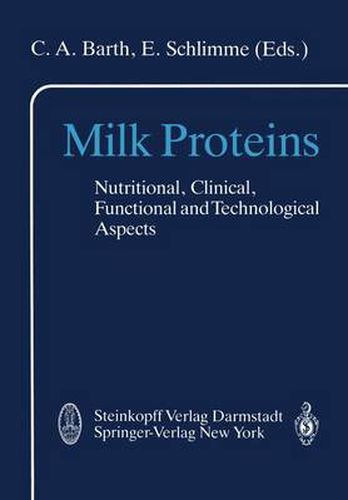Readings Newsletter
Become a Readings Member to make your shopping experience even easier.
Sign in or sign up for free!
You’re not far away from qualifying for FREE standard shipping within Australia
You’ve qualified for FREE standard shipping within Australia
The cart is loading…






This title is printed to order. This book may have been self-published. If so, we cannot guarantee the quality of the content. In the main most books will have gone through the editing process however some may not. We therefore suggest that you be aware of this before ordering this book. If in doubt check either the author or publisher’s details as we are unable to accept any returns unless they are faulty. Please contact us if you have any questions.
This book reviews the state of knowledge and progress of research on food proteins, and in particular, milk proteins. Its basis is the Symposium on Milk Proteins that was held at the Federal Dairy Research Centre in Kiel, FRG, in June, 1988. Scien tists from around the world attended and addressed pure, as well as applied fields of protein research and technology. This book is divided into five sections, each adapted from the symposium’s invited lectures, short communications, and poster presentations. New criteria for the bio logical value of dietary proteins and their relationships are considered according to: - Milk Proteins and Nitrogen Equilibrium - Milk Proteins and Ligands - Milk Proteins: Structural and Genetic Aspects - Milk Proteins: Technological and Functional Aspects - Milk Proteins and Clinical Nutrition Generally, different dietary proteins are classified according to their biological value, i.e., their capacity to cause different retention of nitrogen in the body. But we think there are other intriguing leads worth studying that may help to identify which dietary proteins are best recommended for specific dietary situations or clini cal conditions. In addition, we have taken into consideration new fields such as attempts to determine the three-dimensional structure of proteins using two-dimensional NMR spectroscopy, and the application of genetic engineering to the lactating cell. In other words, we are on the way to the transgenic cow with customized milk constituents and composition.
$9.00 standard shipping within Australia
FREE standard shipping within Australia for orders over $100.00
Express & International shipping calculated at checkout
This title is printed to order. This book may have been self-published. If so, we cannot guarantee the quality of the content. In the main most books will have gone through the editing process however some may not. We therefore suggest that you be aware of this before ordering this book. If in doubt check either the author or publisher’s details as we are unable to accept any returns unless they are faulty. Please contact us if you have any questions.
This book reviews the state of knowledge and progress of research on food proteins, and in particular, milk proteins. Its basis is the Symposium on Milk Proteins that was held at the Federal Dairy Research Centre in Kiel, FRG, in June, 1988. Scien tists from around the world attended and addressed pure, as well as applied fields of protein research and technology. This book is divided into five sections, each adapted from the symposium’s invited lectures, short communications, and poster presentations. New criteria for the bio logical value of dietary proteins and their relationships are considered according to: - Milk Proteins and Nitrogen Equilibrium - Milk Proteins and Ligands - Milk Proteins: Structural and Genetic Aspects - Milk Proteins: Technological and Functional Aspects - Milk Proteins and Clinical Nutrition Generally, different dietary proteins are classified according to their biological value, i.e., their capacity to cause different retention of nitrogen in the body. But we think there are other intriguing leads worth studying that may help to identify which dietary proteins are best recommended for specific dietary situations or clini cal conditions. In addition, we have taken into consideration new fields such as attempts to determine the three-dimensional structure of proteins using two-dimensional NMR spectroscopy, and the application of genetic engineering to the lactating cell. In other words, we are on the way to the transgenic cow with customized milk constituents and composition.